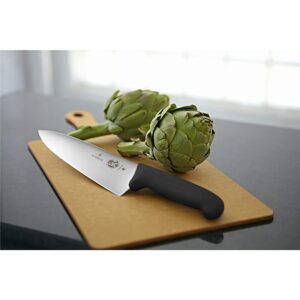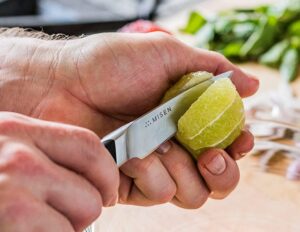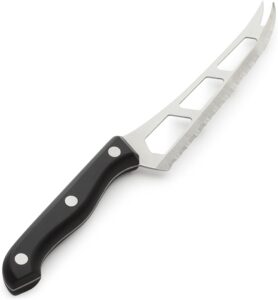Kitchen Knives You Need for Home Cooking: A kitchen knife is the most essential tool any amateur or professional cook should own. A good set of knives will open up a whole world of possibilities when it comes to slicing, dicing, or chopping ingredients to achieve the perfect presentation for your meals.
Knowing which knives and how many of them your kitchen collection will require varies from person to person, but you do not have to spend a fortune on tools that may only be used on special occasions. There are numerous quality knives that will not break bank accounts but still do the same job with absolute finesse.
Remember that it is the skill of the chef and not the knife that can make a great meal. Knives, for any chef, are no more than tools for creating food. However, good knives do have their benefits; they are usually sharper than lower-quality ones and stay sharp for longer. Besides, a sharp knife allows greater control with cutting.
Still, with so many different types of knives on the market today that you could use in your home kitchen, the following four types of knives will be more than enough for the majority of your home cooking tasks. In addition, you will need an all-purpose Chef’s Knife for most sized cutting, a Utility Knife for smaller members of your family who have smaller hands than you do, a paring is perfect for creating a nice presentation to how one cuts their food, and Serrated knives to help better prepare certain ingredients.
Table of Contents
Price You Are Expected for The Knives
There are knives available for each budget out there, from $5 to sky-high. At the same time, the price for medium-range to high-end knives varies from 50$ to 3000$ and even above that. However, there are genuine bargains in terms of money for value, even under the 50$ threshold.
Chef’s Knife

A Chef’s knife has a wide triangular shape blade with 1½ inches width at its widest. The width provides extra leverage when cutting tough ingredients like meats or bones. Blade spine length varies from 6 inches to 14 inches, but around 8 inches is the most common size for home cooking. In comparison, a 10- 12 inches blade is most suited for professional chefs with culinary training.
A few Chef’s knife styles are known — French style, German-style, and Japanese-style. The French-style Chef’s knife will have an almost perfect triangular shape with a straighter edge curving up to the tip. A German-style knife has a wider angle of triangle edge part that allows it a rocking action during usage. A Japanese-style Chef could have French, German, or in-between shape blades. However, it has a lighter weight and a sharper edge. It will be generally constructed from a high-quality, very hard stainless steel alloy. Japanese Chef’s knives are also known under Santoku or Gyuto/Gyutou names.
Victorinox Chef’s Knife
Paring Knife

The same as Chef’s knife, a paring knife has a triangular shape and 2 ½ inches to 4 inches blade length. It is designed with a small and comfortable handle and a sharp tip, so it is accurate to perform any delicate or detailed job. Unlike other types of knives, a Paring knife could be used without a cutting board because its small handle allows the user a lot of control.
Read About : 9 Space Saving Kitchen Appliances for Small Kitchens Or Student Dorm
Utility Knife
Utility Knife was used for most kitchen duties when the chef’s knife was not so popularized. Nowadays, it is mainly used for simple jobs such as preparing meats and smaller cutting tasks. It is also good at filleting small pieces of meat or poultry, trimming veggies, slicing salad ingredients, mincing herbs, or peeling fruit. They can also be used to intricately carve or stylize foods for elegant presentations or garnishes and bigger tasks such as meal preparation.
Also, you will find that using a utility knife is much better suited for delicate jobs when slicing sushi rolls, for instance, since this knife allows for precision over its larger counterparts.
A utility knife is very similar to a chef’s knife. It has an average blade length between 4 and 7 inches, although it also can be anywhere in between. In Japan, the name utility knife is called Petty Knife is the Japanese style of Utility that is so popular now in the West due to its quality material and more extended service.
Serrated Edge Knife

A serrated Edge Knife is a specialty knife for cutting bread, steak, or tomato. The bread knife is the most well-known among them. Other types have a similar serrated edge but differ in size; for example, bread knives have blades up to 10 inches long with serration along all its length, and the steak knife features very sharp serrations and a pointed tip. In contrast, the serrated tomato knife is small with a fork instead of a point.
Although serrated knives have very limited application, they mimic the saw and excel at penetrating through ingredients with a hard outside and a soft inside. The sharp teeth make it possible to cuts finely through bread, cakes, or tomato exteriors and not destroy their gentle interior.
Mercer Culinary Knife
Final Thoughts
If you are a kitchen novice or maybe just want to skip straight to the main course, a good knife for everyday use is all you need. They will serve you faithfully for years with only a minimal amount of care required, such as keeping them sharp (some can be sharpened when their serrations begin to dull) and cleaning them immediately after use.



